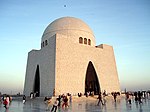
Federal Capital Territory (Pakistan)
| Federal Capital Territory | |||||||||
|---|---|---|---|---|---|---|---|---|---|
| Former Federal Territory of Pakistan | |||||||||
| 1948–1959 | |||||||||
|
Flag | |||||||||
 Map of Pakistan with the FCT highlighted | |||||||||
| Capital | Karachi | ||||||||
| Area | |||||||||
• | 2,103 km2 (812 sq mi) | ||||||||
| History | |||||||||
• Karachi established as capital of Dominion of Pakistan | 1948 | ||||||||
• Capital moved to Rawalpindi. Federal Capital Territory merged into West Pakistan | 1959 | ||||||||
| |||||||||
| Today part of | • Sindh Pakistan | ||||||||
 |
| This article is part of the series |
| Former administrative units of Pakistan |
|---|
| Part of a series on the |
| History of Karachi |
|---|
 |
| Prehistoric period |
| Ancient period |
| Classical period |
| Islamic period |
| Local dynasties |
| British period |
| Independent Pakistan |
The Federal Capital Territory (FCT) around Karachi was the original capital territory of Pakistan. The FCT was created in 1948 from the city of Karachi and surrounding areas as the location for Pakistan's capital following its creation.[1] This move, however, was controversial as the territory was created despite resistance from the local groups in Sindh.[2] The FCT was bordered by the province of Sindh to the northeast and the princely state of Las Bela to the northwest with the Arabian Sea to the south.

History
Karachi became the first capital of the new country of Pakistan in 1947. The FCT was created in 1948 to enable the federal government to operate from a nationally-held territory. At that time it had a population of 400,000 people which began to increase rapidly because of the political focus on the city and the fact that it was the major commercial seaport for western Pakistan. When the territory was absorbed into the province of West Pakistan, the city had a population of about 1.9 million.

The main ethnic groups in this region before the partition of the Indian subcontinent consisted of several small linguistic and religious groups such as Sindhi Hindus, Sindhi Muslims , Baloch Makranis,Gujarati communities, which included Parsis, Hindus, Sunni Muslims, Ismaili Muslims, Daudi Bohras, Marwari Muslims, Kacchi Muslims, and a large number of local Christian communities. A considerable number of Sindhis and Balochs resided in sporadic villages in this region.The majority spoken language was Sindhi spoken by 52% of population as per 1946 census.However, all of these communities were collectively and simultaneously outnumbered by the inflow of Muslim Muhajir who started settling in Karachi because it was the federal capital as well as the largest commercial hub; and somewhat due to Hindu communities' migration from this region to India, resulting in dramatic and demographic changes in this area.

Geography and climate
The Federal Capital Territory occupied 2,103 km² compared to the current City-District of Karachi which occupies 3,527 km². Apart from Karachi City, the Federal Capital Territory also contained several small villages and towns which have now been subsumed in the metropolitan area of Karachi. The territory covered rolling plains bound by hills to the north and west, the river Indus to the east, and the Arabian Sea to the south. Several smaller rivers flowed through the heart of the territory including the river Malir and the river Layari. The Port of Karachi was located in a protected bay to the southwest of the city, protected by several small islands. The climate of the territory was moderated by the influence of the sea with relatively mild winters and warm summers. There was low precipitation and high humidity for much of the year except during the short monsoon rains.

Economy and transport
Karachi was, and still is, the financial capital of Pakistan, accounting for the largest share of the nation's GDP and generating the largest share of the national revenue. The State Bank of Pakistan and most commercial banks had their headquarters in Karachi together with Pakistan's first and largest stock exchange - the KSE now PSX.

The FCT was served by the old Quaid-e-Azam International Airport (now Jinnah International Airport) terminal which is now used for Hajj flights and cargo facilities. In addition, there was an airport at Mauripur which is now the Masroor Pakistan Air Force base. In 1947, Karachi had the only major port in western Pakistan while Chittagong was the main port for eastern Pakistan. The city was linked to the rest of West Pakistan by railway with the main stations at Karachi City Station and Karachi Cantonment Station.

See also
References
- ^ "About Karachi". www.kmc.gos.pk. Archived from the original on 2016-06-23. Retrieved 2023-01-15.
- ^ Suhail, Adeem; Lutfi, Ameem (October 2016). "Our City, Your Crisis: The Baloch of Karachi and the Partition of British India". South Asia: Journal of South Asian Studies. 39 (4): 895. doi:10.1080/00856401.2016.1230966. ISSN 0085-6401.
Most significantly, the government of Pakistan declared Karachi a federally administered zone despite resistance from the local political classes in Sindh.
External links
- The City-District Government of Karachi Archived 2002-03-25 at the Wayback Machine

See what we do next...
OR
By submitting your email or phone number, you're giving mschf permission to send you email and/or recurring marketing texts. Data rates may apply. Text stop to cancel, help for help.
Success: You're subscribed now !

